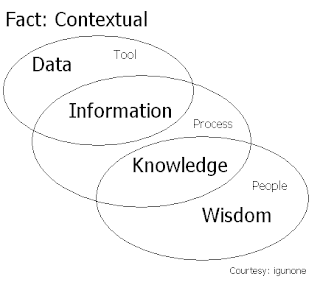Hikmah
Hikmah tersebut tersimpan di ingatan & dikonsumsi kalbu, mempengaruhi perilaku individu, dari pikiran, keyakinan, niat sampai amal perbuatan.
Hikmah memiliki korelasi dengan fakta & peristiwa, baik korelasi positif atau negatif. Korelasi positif adalah sebuah kejujuran & kesempurnaan, sebaliknya adalah sebuah kebohongan & kerusakan.
Korelasi hikmah dengan fakta melewati suatu proses yang saling terkait membentuk rantai. Fakta terbaca & terekam menjadi data. Data diformat & disajikan menjadi informasi. Informasi diserap & dipahami menjadi pengetahuan. Akhirnya pengetahuan yang terproyeksikan dalam niat & amal menjadi hikmah. Amalan kita kembali menjadi fakta tentang perilaku kita sebagai individu, baik fakta bagi diri kita sendiri maupun fakta bagi sosial lingkungan dan alam semesta. Demikian rantai ini berulang.
Namun, tidak semua fakta dapat menjadi hikmah. Karena jika fakta tidak terbaca & terekam, maka tidak ada data. Jika data tidak tersajikan, maka tidak ada informasi. Jika informasi tidak terserap & terpahami, maka tidak ada pengetahuan. Akhirnya jika pengetahuan tidak terproyeksikan dalam niat & amal, maka hikmah tidak akan pernah ada.
Kita tersusun dari kumpulan hikmah sejak lahir sampai liang lahat. Ketika rantai hikmah ini terputus, maka hikmah akan tersimpan di ingatan sebatas pengetahuan yang dapat saja terlupakan.
Kita hidup dengan kumpulan hikmah ini. Lingkungan seputar kita berkontribusi terhadap hikmah di ingatan kita masing-masing. Dari orang-tua, keluarga, anak-anak kita, sahabat & teman, sampai hewan peliharaan & kepemilikan kita. Semua memberikan hikmah di ingatan kita. Tatkala rantai hikmah tersebut putus, maka kita akan merasakan kehilangan, sesuai dengan derajat nilai penghargaan kita terhadap hikmah tersebut. Contoh adalah ketika kita kehilangan orang yang kita cintai, maka kalbu kita mendeteksi suatu rasa kehilangan akibat putusnya rantai hikmah. Atau sekedar pergi merantau ke negeri yang jauh, maka kalbu kita merasakan kerinduan disebabkan terpisahnya hikmah dengan fakta oleh jarak.
Demikianlah hikmah membentuk kita sebagai individu. Semoga kita memiliki hikmah yang positif untuk rantai yang positif.
Wallahu'alam bishowab.
Salam,
(a Lesson learned from the passed away story of Ibrahim, son of Rasulullah Muhammad SholallahuAlaihiWassalam from his mother Maria Al-Qibtiyya while still infant)






